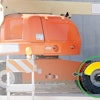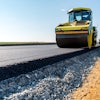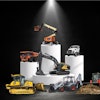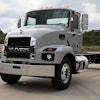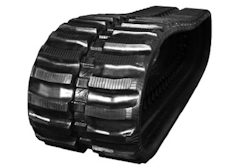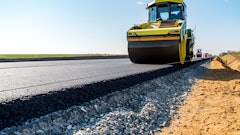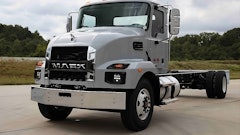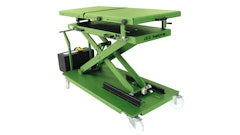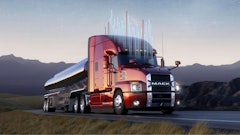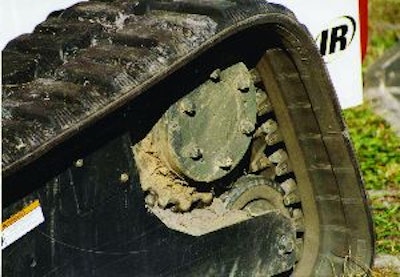
In today's construction market, it's tempting to cut corners when replacing or maintaining key components. This is particularly true of rubber tracks, which have become increasingly popular on compact excavators, compact track loaders, asphalt pavers, crawler carriers, high-speed dozers, etc.
While purchase price is important given the current state of the economy, it is also important to consider the overall hourly cost of the track.
"Buying the cheapest you can get is not always the best option," says Jared Steier, product manager for rubber tracks, Solideal USA. "You need to know who you are buying from. There are products that do a better job than others. You can't call and scream at the Internet. You need someone who will pick up the phone."
"There is a huge difference on who your track supplier is," agrees George Zafirov, marketing manager, McLaren. "Make sure you understand the history of the product -- where it comes from and if there are complaints. Basically, do some research. There are dozens of sources for track."
Rubber tracks are a highly engineered wear item, states Dennis Hare, who sells rubber track as a business manager for Veyance Technologies, exclusive manufacturer of Goodyear Engineered Products. "While materials may look similar, performance can vary greatly," he points out. "We have several different compounds that perform in different applications. And we are typically producing about a dozen different tread designs."
Construction methods for rubber tracks vary by manufacturer, and there are differences in the amount of rubber, the quality of the steel and the way the cables are connected (continuous wound vs. overlapping connections).
"When we make rubber tracks, different layers of track use different kinds of rubber," says Zafirov. "For example, the tread is always hard rubber and the inside is a softer rubber, because the inside is supposed to flex while the tread on the track needs to withstand the conditions. We use five layers of rubber compound, depending upon which part of the track the rubber is supposed to go." Some manufacturers may use just one kind of rubber throughout their track construction.
Construction technique can also make a big difference. For example, if the steel cables aren't the same circumference within the rubber track, the shorter cable can cut the tracks internally. Quality manufacturers have developed methods to ensure all of the cables are the same circumference. "These small differences make a track more expensive, but then you don't have an agent that cuts from the inside," says Zafirov.
You need to understand your machine, as well. For instance, a track with a continuous wound steel cable may be an asset on a compact track loader with high pushing forces, but may not be as important on a compact excavator. "A continuous cable track on an excavator is not a huge advantage because that is not a feature that is required for operation," says Zafirov. "When it comes to mini-excavators, it is more about rubber compounds and durability rather than the steel cables. It is going to be the rubber cracking from sun exposure."
Conditions Influence Longevity
Veyance Technologies has seen an increasing popularity in smooth tread patterns for asphalt paver tracks. "Customers tell us the smooth tread improves the paved surface, as well as makes the edge of the track more cut resistant, while providing better wear life," notes Hare.
McLaren carries a number of tread patterns, including application-specific treads. "Some have more aggressive structure than others," says Zafirov. "Our new Turf Glide series for compact track loaders has a smooth tread pattern that is very turf friendly."
But even specialized rubber tracks can't meet the needs of every environment. "Wear characteristics vary drastically depending upon the job environment," says Raymond Oh, North American sales and marketing manager, DRB America. "It would be wise to first check if your piece of equipment is suited for the job. Often, sharp edges of projectiles and rocks cause cuts and tears on the rubber track. Other times, outside objects get stuck in the undercarriage components and destroy the tracks from the inside of the undercarriage."
"The most important thing about rubber track wear and maintenance, and making sure you get the most [return] for your buck, is the environment of that application," agrees Steier. "What I always tell folks is when you are bidding for a job, take into account the application that you are running and bid accordingly."
Various terrains will eat up rubber differently, notes Zafirov. "Some terrains will allow that rubber track to last longer," he indicates. "If you go on a normal site where you have occasional debris, then you have normal wear and tear. There will be some cracks and nicks from nails and debris, but your tracks will be fully operational and you won't have equipment downtime. Then, you have some track-friendly environments on a non-abrasive construction site where there will be almost no wear on the tracks. If you go from light to normal construction conditions, you will have light to normal wear and tear. And if you go to extreme environmental conditions, that will be detrimental to the tracks."
In addition to the work environment, operators need to understand the nuances of operating a rubber track machine.
"Zero-radius turns on a skid steer may be something you have done for the last eight or 10 years," Steier acknowledges. "When you go to a compact track loader, you can do the same thing. But instead of dragging four tires with a very small contact point, you are dragging two very large tracks with a large contact point. You need to take into account that you are wearing an expensive item and you need to do that carefully. You really need to do three-point turns when you are on concrete or asphalt."
Even though compact excavators typically don't spend a lot of time traversing the jobsite, operators can still play a large role in how the tracks wear. "Always be prepared for the trips from the trailer to the dig site," advises Steier. "That means making sure you have boards to get up over curbs. Make sure you take out fence posts that could come up and hurt the machine or undercarriage."
Undercarriage Wear Affects Track Life
Check for uneven undercarriage component wear. If some components wear more quickly than others, it can affect productivity and wear on all components, including the rubber tracks.
"The life of the undercarriage system is driven by wear," says Guido Bottin, vice president of operations, Berco of America. "A system that is well balanced (properly aligned) wears evenly, maximizing the investment.
"For example, if the rollers are not aligned, the operator may experience a de-railing problem that could cause a lot of damage," he explains. "A misaligned undercarriage system will also load some components more than others, creating situations where some parts may fail prematurely."
"Some people don't take into account that all undercarriage parts are wearable components," says Steier. The components on a 1,000-hour compact track loader will be worn significantly compared to a brand new unit. "You can see that the rollers are smaller. They have grooves in them. The sprockets have worn over time to become very sharp. By putting that new track on that same undercarriage that has 1,000-hour used parts, the wear characteristics are going to be vastly different."
He points out, "We have seen situations where failure to maintain the undercarriages has led to failures in rubber tracks. The leading culprit is going to be the sprocket. Sprocket pitch and pitch of the track are identical."
Assume the pitch of a sprocket was 86mm when new. After 1,000 hours, that sprocket may have a pitch of 93 or 95mm. When you put on a new rubber track with an 86mm pitch, you may start to hear popping noises. "That is the sprocket hitting on top of the metal piece of the track, causing it to wear," says Steier. This really stresses the metal components in the track.
"Maintaining the rubber tread on your rollers and idlers is pretty important," says Hare. "We ran a considerable fleet study in 2006, and our findings were that tracks on brand new undercarriages lasted 16% to 20% longer than the same track used as a replacement." This may be attributed to the worsened condition of the idlers and rollers on older machines.
"Also, through monitoring warranty, we've correlated unusually severe track damage to undercarriages in a state of disrepair (e.g., idlers and rollers with missing tread rubber)," Hare states. "Machine manufacturers include convenient means to align, and customers have learned to check and align tracks, if needed, on regular enough intervals, so that track removal due to misalignment is somewhat rare."
Of course, tracks do wear out, one way or another. "The rubber wears out, which happens after an extended service life; that is the normal rubber track failure," Zafirov states. "Then, there is premature track failure, which typically happens when you have a core component failure, such as the steel cables inside."
"It gets to the point where most tracks get to the end of their service life and they actually end up breaking," says Steier. "Because of the high expense, [contractors] will work them until they get the last workable hour out of them."

